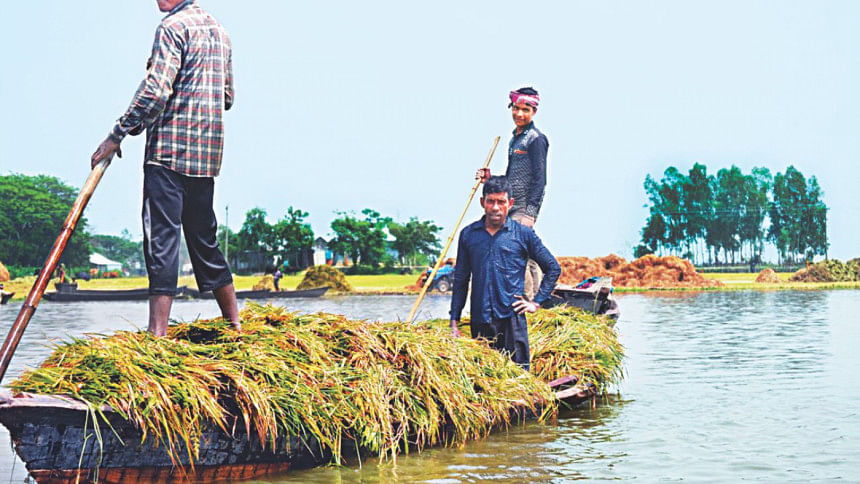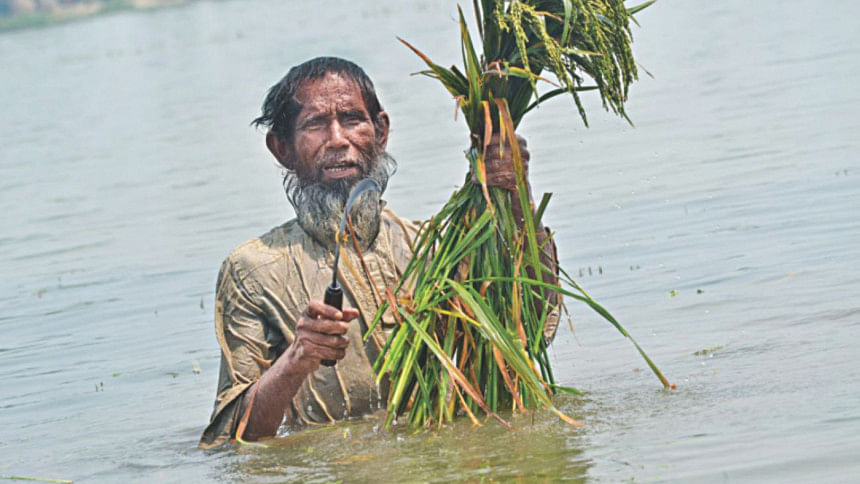Havoc in haor

Farmers in the northeastern backswamp are all too familiar with flash floods. Rice paddies grown just once a year in this vast haor remain at the mercy of nature.
But thousands of growers in this wetland ecosystem had never experienced flash floods striking this early as in this season, completely destroying paddies in over one lakh hectares of land.
Experts said flash floods usually wreak havoc here in the haors in April but this time crops went under water on March 27. They attributed the phenomenon to climate change.
The flash floods submerged the wetland of Sylhet, Sunamganj, Habiganj, Netrokona, Kishoreganj, Brahmanbaria and Moulvibazar.

Losing the only crop of the year, many farmers in Sunamganj, Kishoreganj, Netrakona, Habiganj and in some other northeastern districts are now selling their cattle and other valuables while many others are leaving their homes for nearby towns to find manual work.
Rashid Ali from Damodar Api village in Dakshin Sunamganj usually sells around eight tons of rice grown in over 10 acres of land. But this year he could not harvest even a kilogram.

"I had seven cows. But I have already sold four of them to repay loans that I took to cultivate rice. I am not sure how would I run my family now," he told The Daily Star.
Farmers from other haor regions also started selling their cattle to tide over the crisis.
Mohammad Mainuddin, 50, member of Sizadpur union in Habiganj's Baniachong upazila, said he had never seen such early flash floods in that region.
"This is the worst situation we can remember. Many people in our village harvest 20 tons of Boro rice every year. But this time they would not harvest even a handful of rice,” he said.
Mainuddin explains, the farmers mostly cultivate two kinds of Boro crop that they were supposed to harvest in the last week of Chaitra and the first week of Baishakh (second and third week of April). But this year the flash flood hit 15 to 20 days early destroying all the mature paddies in the field.

EARLY FLASH FLOOD
Prof AKM Sailful Islam of the Institute of Water and Flood Management at the Bangladesh University of Engineering and Technology (Buet) said when the water level of the Surma river at Sunamganj station of Bangladesh Water Development Board (WDB) crosses the 6.5 metre-mark during March-April, they consider it as the beginning of flash flood.
He said all the other flash floods since 2000 hit the Haor areas in mid April and by then the farmers were able to harvest a major portion of the Boro crops.
"Last year, the flash flood hit on April 17, but this year the flash flood came on March 27," Prof Saiful said.
He attributed change in season from climate change to this early flash flood. The intensity and frequency of extreme weather has been changing also due to climate change, he said.
"We were not prepared for the situation as well. There are news reports many of the embankments in the haor area were either not repaired or remained damaged.
“So we were not prepared for it," the professor said.
Again, the department of meteorology or Flood Forecasting Warning System doesn't have any special warning system for flash flood.
Samarendra Karmakar, a meteorologists and an ex-director of Bangladesh met office, also pointed to climate variability for this year's early flash flood.
"This year flash flood took place earlier than usual. But nobody can exactly say why this climate variability happens.”
This year easterly low pressure was active and sub tropical high in the Bay of Bengal was weak that caused rainfall in the Himalayan region in India, he said as a possible explanation.
HOW MUCH CROPS DESTROYED
Zahidul Haque, deputy director at the Department of Agricultural Extension (DAE) in Sunamganj, said farmers in the haor area of the district cultivated Boro crops in some 1.6 lakh hectares in the district. Of them, around 1.13 lakh hectares have been submerged while crops in about one lakh hectare have been completely destroyed.
“Our estimation says farmers would face a loss of Tk 1 lakh for per hectare of land,” he said.
The department is yet to estimate the total amount of financial loss in the area, said Manzurul Hannan, director general of DAE. He said farmers cultivated Boro rice in 4.5 lakh hectares of haor this year and an estimated 1.41 lakh hectares went under water.
However, data collected by our correspondents from the district agricultural offices shows around 2.5 lakh hectares of land was submerged in the flash floods.
Asked, he expressed his hope that the government, despite this havoc, would be able to reach its target of Boro harvest this year due to a good yield in other places of the country.
Boro contributes 55 percent to the annual rice output and was cultivated in 48 lakh hectares of land. Last year, total 1 crore and 89 lakh tonnes of Boro rice was produced in the country.
[Our Mymensingh correspondent contributed to this report]



 For all latest news, follow The Daily Star's Google News channel.
For all latest news, follow The Daily Star's Google News channel. 



Comments